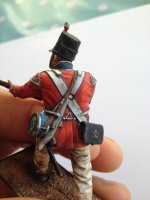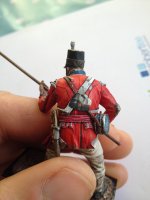Hi...Just spotted this question.
These knapsacks were patterned at different times. The rectangular one was based on old illustrations by Knötel, and were perhaps a best guess reconstruction.
This is pretty common with earlier uniforms where little material culture for the common infantryman survives. Trousers, shirts, shoes, socks and braces are the probably the most rare items as they were worn until they were useless, or sold off to civilians. This is often followed by simple equipment that although produced in thousands, become obsolete and issued until existing stocks are worn out, destroyed, discarded or sold to other countries.
The newer knapsack we are using is based on a surviving one in the Swedish army museum that was clearly surplus from the British army and was probably part of a stand of arms and equipment sent to Sweden by the British to insure that their relationship was mutually beneficial against the French. This example was clearly marked for the British 1st Foot Guards and was complete with all straps and a fine example of the British cylindrical mess tin with linen cover as illustrated in paintings from the same period by Denis Dighton.
The Bruswickers were supplied from British stores, so I upgraded the newer releases with this knapsack and mess tin.
The Figures:
The earlier ones have a tapered square locating lug on the rear face along with a female receiver in the back of the figure. Later ones use a round pin with a hole in the back of the figure. If you would like to change them some may be harder to remove than others. Many are soldered, a few are super glued. Either way they can be modified when removed by grinding away the male connector and relocating them on the rear of the figure using higher viscosity CA (super) glue. Plan on some touch up...but this can be done with acrylic paints.
Another note...by the 1780s many knapsack were painted with linseed oil based paints to make at least the flap water resistant. Sometime around 1808-10 it seems that black became more common as a color and additives were used to "improve" the finish. When these painted items were new the finish had a bit more luster to them, although it was short of what I would call glossy.
Take a look at the 1866 US Army Quartermaster photographs to see the finish on the double bag knapsacks and haversacks and you will see what I mean.
Sorry to go on...but I hope it helps.
Ken



